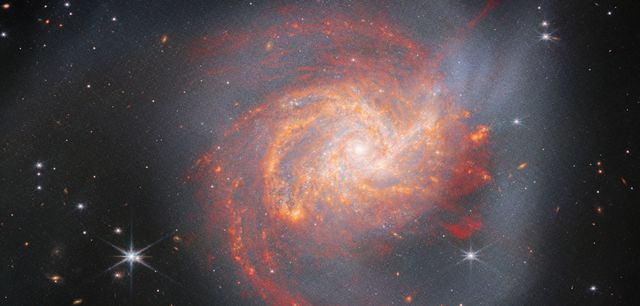07 December 2023
As we all know from school, our universe began with the Big Bang. But what actually happened during and after this cosmic event? How come we can say anything about it at all? And did the Big Bang really make an unimaginable amount of noise?
How did the universe begin? This question has occupied the human race for thousands of years. Religions of various stripes have attributed its creation to one or more gods, and continue to do so. As well as the origin, Norse mythology also has something to say about the end of the world – including the next new beginning. The Greek philosopher Aristotle, on the other hand, was of the opinion that the world had existed forever and was permanent and imperishable. And Albert Einstein also initially held the view that the universe had no beginning in space and time.
The universe is growing
By the end of the 1920s, however, astronomers such as Edwin Hubble had noted that the galaxies which surround our world seemed to be moving further and further away from us. The Belgian astrophysicist and theologian Georges Lemaître was the first to conclude that the universe was expanding. It's not that the other galaxies are hurtling further and further away from us; instead, space itself is growing and getting bigger and bigger between the galaxies. This is analogous to a mass of rising dough in which the raisins are moving further and further away from each other. Or dots on a balloon that move further and further apart as it inflates.
If we reverse this expansion movement, we get a single point at which the entire energy of the universe must have been concentrated. Georges Lemaître coined the term “singularity” in 1927 and started a new chapter of the history of the cosmos with the idea of the Big Bang. According to this theory, before it all began the universe was infinitely small and incredibly dense – as if all the galaxies had been compressed to the size of an orange. Then, within a few fractions of a second, the compressed energy expanded at infinite speed from an infinite number of points. And this was not like an egg that explodes in the otherwise empty space of a microwave: after all, according to the theory, space and time only came into being in the first place with the Big Bang.
Talking of microwaves, Lemaître and others were of the opinion that it should still be possible to measure radiation from the time immediately after the Big Bang. Physicist George Gamow performed the corresponding calculations and predicted the existence of thermal background radiation in the microwave range. He was right – exactly this background radiation was discovered in 1964 by physicists Robert Wilson and Arno Penzias. This is now considered the most robust proof of the Big Bang theory.
From the primordial soup to the transparent universe
In 2013, the Planck telescope took a close look at the background radiation of the entire sky and created what one might call a “baby photo” of the universe. The cosmologists were then able to get a more concrete picture of what the universe looked like 380,000 years after the Big Bang.
What happened before that is an impenetrable mystery that not even the background radiation can directly explain. It was only around this time that solid atoms were formed and the universe became transparent – i.e. translucent. Previously, according to the theory, the young universe was a primordial soup of hot and dense plasma, through which light could not spread. And which is therefore also invisible to our telescopes.
After all, to look back into the past, telescopes need light. The farther away the galaxy is from which they capture light particles, the older it is. And light was just not yet able to spread in the cosmic primordial soup. Which is why even the very best telescopes are blind when it comes to the very beginning.
Determining the age of the universe
Not withstanding this obstacle, researchers can still use the background radiation to calculate how much energy and heat must have been released during the Big Bang. And when it probably took place: Our universe began around 13.82 billion years ago.
Not only that, but the James Webb Telescope, launched in 2022, has allowed us to look far more deeply into the past: Thanks to its highly sensitive infrared sensors, it can detect more distant, i.e. older, objects than any previous telescope. And in doing so, it has already discovered galaxies that must have formed around 300 million years after the Big Bang.
Without time, there is no “before”
When it comes to the first few minutes and millennia after the Big Bang, researchers can only speculate and create models. Or reconstruct them using particle physics experiments. With their huge particle accelerators, scientists can look back to just three minutes after the Big Bang. The Big Bang itself, however, thwarts all their experiments. Ironically, it is also not part of the Big Bang theory. According to the theory, time and space only came into being with the Big Bang. Meaning that it is not possible to speak of a “before” at all. And what could have triggered the Big Bang is also just a matter of speculation.
Silent Big Bang?
But what can confidently be said is that there wasn't a big bang at the beginning of the universe. This is because sound waves need a medium such as air or water to spread. However, chemical elements such as hydrogen did not form until microseconds after the Big Bang. The Big Bang theorists should not however be blamed for the perhaps somewhat skewed language that gets used. The term was coined in 1949 by the astronomer Fred Hoyle, who wanted to make fun of the theory that he himself did not consider conclusive. Even so, the name “Big Bang” has stuck. After all, it is probably simply more catchy than “primordial expansion theory” or whatever other designations you might come up with. And, in any case, it definitely packs more of a punch.



